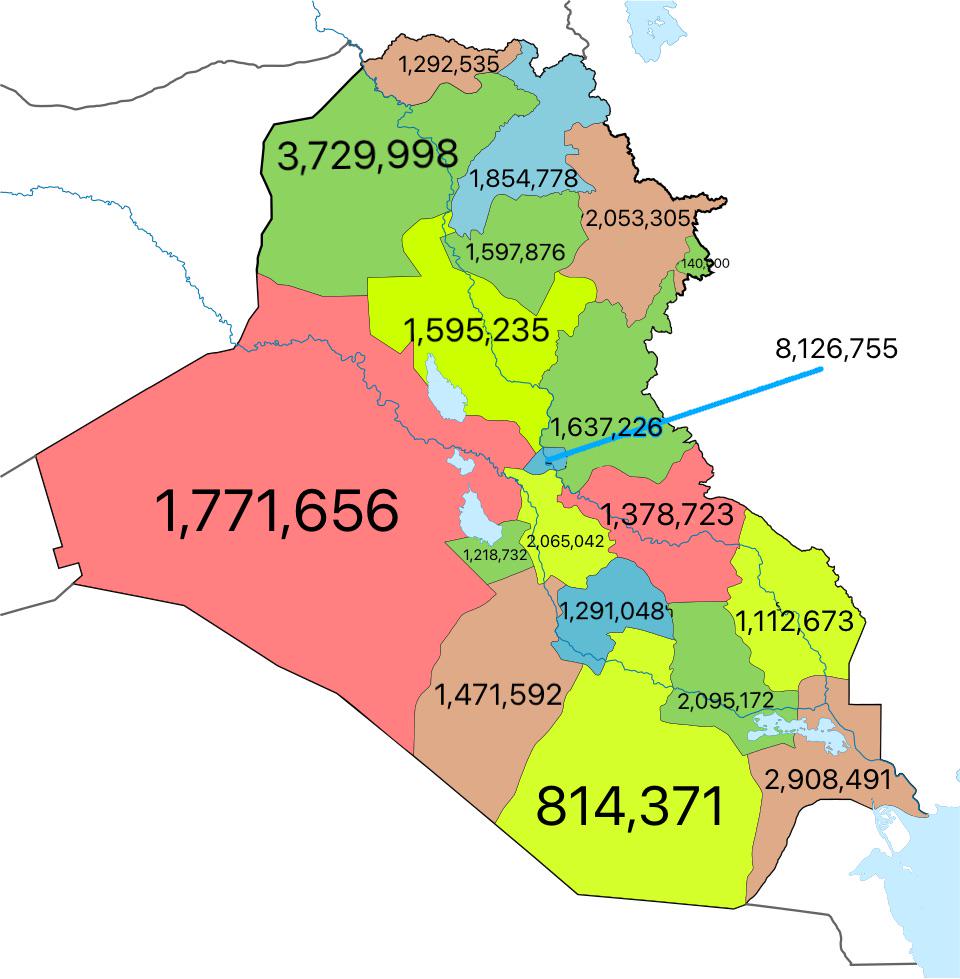Iraq Population Map by Governorate


Marcus Rodriguez
Historical Geography Expert
Marcus Rodriguez specializes in historical cartography and geographic data analysis. With a background in both history and geography, he brings unique...
Geographic Analysis
What This Map Shows
The "Governorates of Iraq by Population Map" provides a detailed visual representation of the population distribution across Iraq's governorates. This map highlights the varying population sizes in each of the 18 governorates, offering insights into urbanization, demographic trends, and regional development. Understanding these population dynamics is crucial for grasping the broader socio-economic landscape of Iraq.
Deep Dive into Iraq's Population Dynamics
Iraq's population is a rich tapestry woven from diverse ethnic, cultural, and religious backgrounds. As of the latest estimates, the population of Iraq stands at approximately 42 million people, with significant concentrations in urban areas. The capital city of Baghdad is the most populous governorate, housing around 8 million residents. This concentration of people in urban centers is a key characteristic of Iraq's demographic landscape.
Interestingly, the population density in Iraq varies greatly across different regions. For instance, while Baghdad and Basra are densely populated cities, the sparsely populated governorates like Al-Qadisiyyah and Muthanna reflect the rural nature of their surroundings. Urbanization has led to a shift in population from rural areas to cities, as individuals seek better economic opportunities and access to services.
Moreover, the age structure of Iraq's population is also noteworthy. A significant percentage of the population is under 25 years old, which indicates a youthful demographic. This youthful population presents both opportunities and challenges; while it provides a vibrant workforce, it also necessitates substantial investments in education, healthcare, and job creation to avoid high unemployment rates.
In terms of ethnic composition, the population includes Arabs, Kurds, Turkmen, and various minority groups. The Kurdish region, primarily located in the north, has its own distinct demographic characteristics, often showing higher growth rates compared to other regions. The presence of diverse ethnic groups contributes to the cultural richness of Iraq but can also lead to tensions, particularly in mixed governorates.
Regional Analysis
Breaking down the population data by regions reveals intriguing patterns. For example, the southern governorates, such as Basra and Dhi Qar, are characterized by agricultural economies and have seen population increases due to internal migration driven by the search for jobs. On the other hand, the northern governorates, like Erbil and Sulaymaniyah, have emerged as economic hubs in recent years, attracting both local and international investments.
Baghdad stands as a stark contrast, being a melting pot of cultures and a major political and economic center. Its population has fluctuated due to historical conflicts, yet it remains the most populous area in Iraq. In comparison, governorates such as Anbar and Nineveh have been significantly affected by conflict and displacement, leading to population declines in certain areas while others have seen an influx of displaced persons seeking safety.
Interestingly, the demographic shifts are also influenced by migration patterns. For instance, many Iraqis have sought refuge abroad due to conflicts over the past decades, while others have returned, reshaping the population dynamics in various regions.
Significance and Impact
Understanding the population distribution in Iraq is vital for multiple reasons. It informs governmental planning, resource allocation, and infrastructure development. As Iraq continues to rebuild and stabilize, knowing where the population is concentrated helps in strategizing for social services like education and healthcare.
Moreover, the youth bulge presents both a challenge and an opportunity. With the right investments in human capital, Iraq can harness this demographic dividend to spur economic growth. Conversely, failing to address the needs of this young population could lead to increased unemployment and social unrest.
In terms of future projections, the population of Iraq is expected to continue growing, albeit at a slower pace. Policymakers will need to address urbanization challenges, such as housing shortages and traffic congestion in cities, while also focusing on rural development to balance the population distribution.
In conclusion, the "Governorates of Iraq by Population Map" is more than just a visualization; it encapsulates the intricate demographic trends that define Iraq. By understanding these patterns, we can better appreciate the socio-economic challenges and opportunities that lie ahead for this dynamic nation.
Visualization Details
- Published
- October 30, 2025
- Views
- 2
Comments
Loading comments...